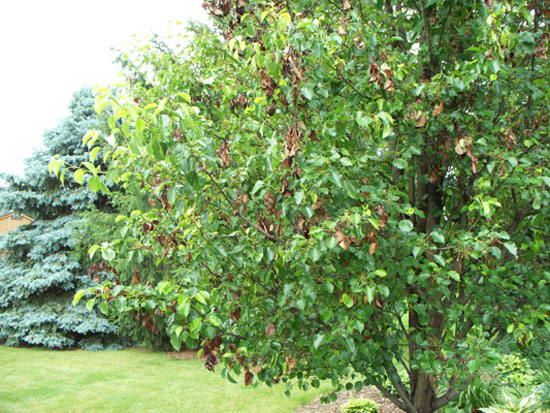Issue 7, June 4, 2010
Fire Blight of Ornamental Pear
This has been the week for symptom expression of fire blight on ornamental pear, at least in parts of Illinois. I have heard of multiple samples in Champaign, Sangamon, and Vermilion counties. We have received physical samples from Champaign and St. Clair counties. Symptoms seen now were initiated by infections from 5 to 30 days ago.
Fire blight is caused by a bacterium, Erwinia amylovora. In fact, the first person to prove a bacterium can cause plant disease was Dr. T.J. Burrill from the University of Illinois. He did this in the late 1870's with fire blight. Since then, we have understood that fire blight is the limiting factor in pear production in this state. Ornamental pears are popular trees in the Midwest, but they are also susceptible to fire blight. 'Bradford' callery pear is fairly resistant to this disease, but it is not immune. 'Aristocrat' is more susceptible. 'Chanticleer' is reported to have good resistance. 'Redspire' is susceptible. I have found conflicting reports on resistance and susceptibility to this disease. It is most likely that trials for limited times and too few locations of these trials may be the reason for conflicting reports.
The fire blight bacterium infects in warm (>60 degree F), humid conditions. The primary mode of entry into the plant is via flowers, so the critical infection period is during bloom. Infection can also occur via wounds, especially after wind or hail storms. The bacterium moves systemically in plants to shoot tips. Blighted leaves and blossoms near twig tips appear first. Leaves may wilt and turn brown or black. The image shows an infected tree this spring, courtesy of Sandy Pepper. Typical shepherd's crooks at stem tips are evident in her second image. Stem cankers develop as sunken, cracked areas on stems. The bacterial pathogen may live over winter in these cankers. The bacterium oozes from these cankers in the spring, attracting insects. The insects spread the bacteria to blossoms, fruit, or other plant parts. Water may also spread the bacteria. We also contribute to spread via pruning tools.

Photo courtesy of Sandy Pepper.

Photo courtesy of Sandy Pepper.
When severe stem death occurs, the major concern is what can be done now. There is no effective management option for infected trees. Prune out infected wood in the dormant season, if you can wait. If not, prune in an extended dry period and disinfect pruning tools after every cut. The bacterium may have extended down the stem ahead of the canker. Unfortunately this means wood should be removed 8-10 inches below the edge of the visible canker. Chemical options are limited for home growers because the timing of sprays is so critical. Commercial growers apply copper products in the dormant season and streptomycin at 4-5 day intervals throughout bloom. Don't try to fix this problem with fertilization and watering. You will promote lush growth which is more susceptible to infection by the fire blight bacterium.
There is a University of Illinois report on plant disease (#801) discussing fire blight. For those interested in the commercial epidemiological aspects of fire blight, consult this March, 2010 article in Plant Management Network.--Nancy Pataky
Author:
Nancy Pataky